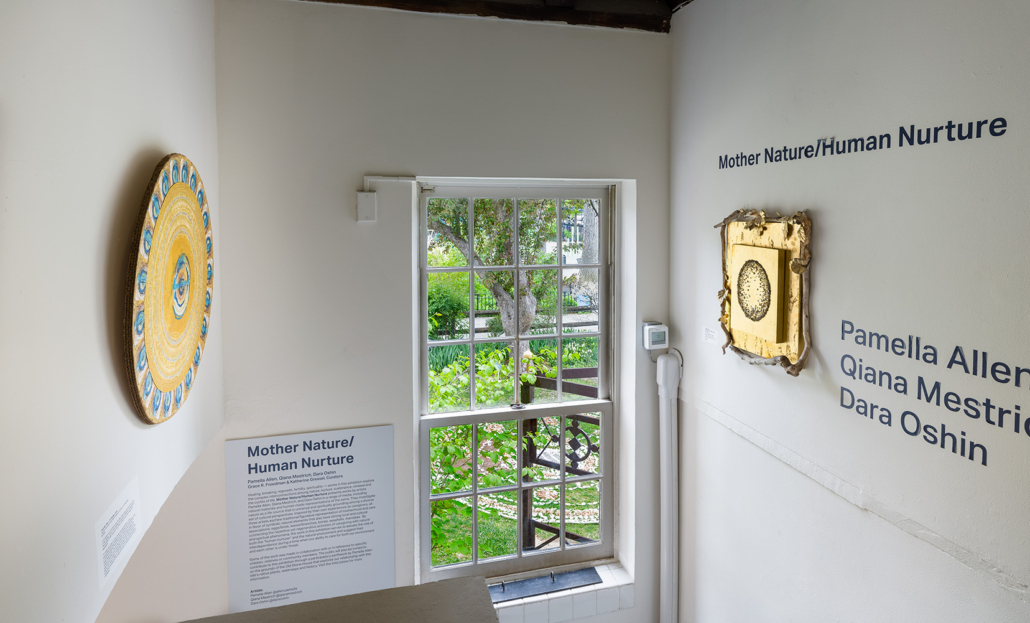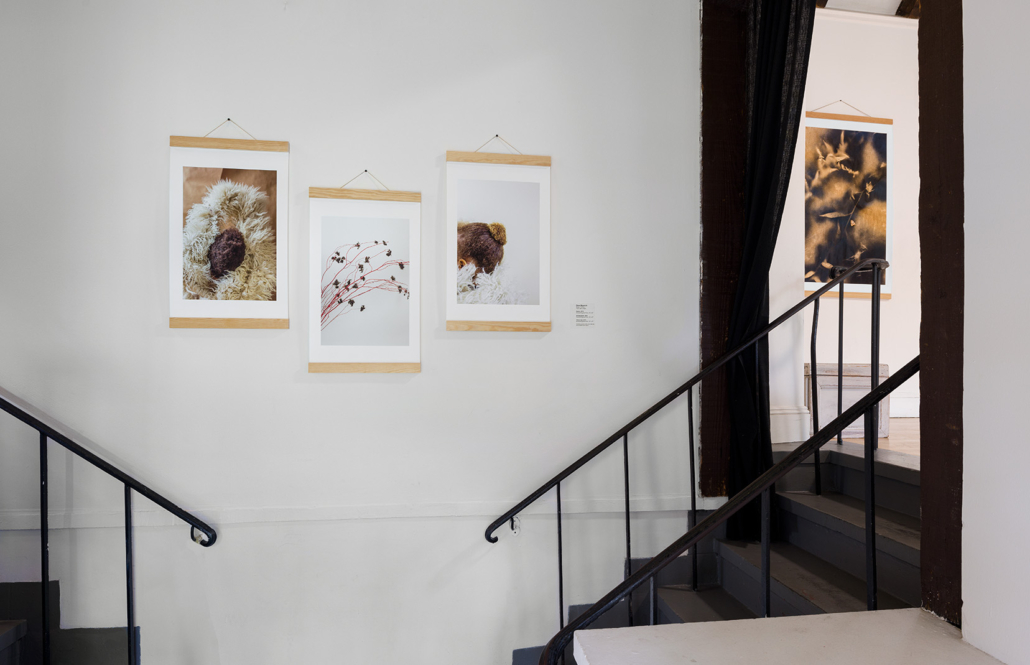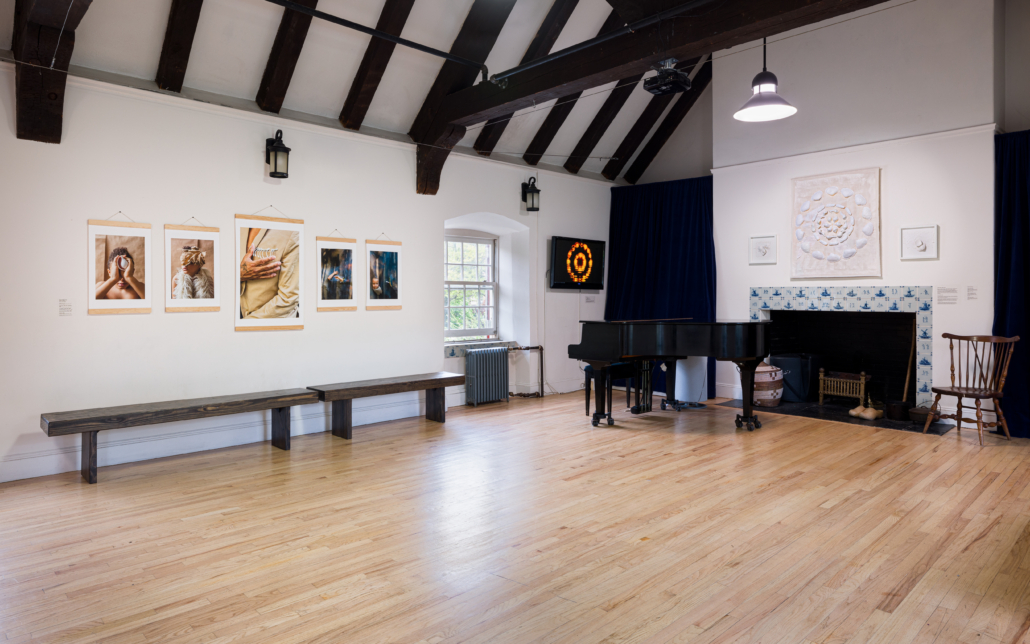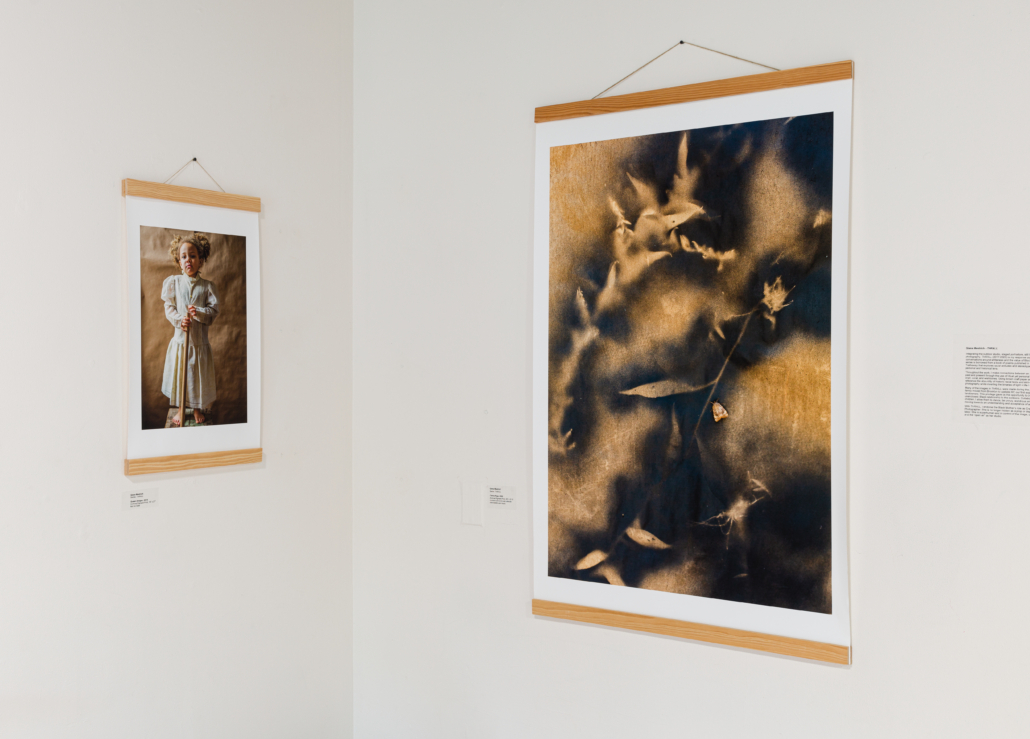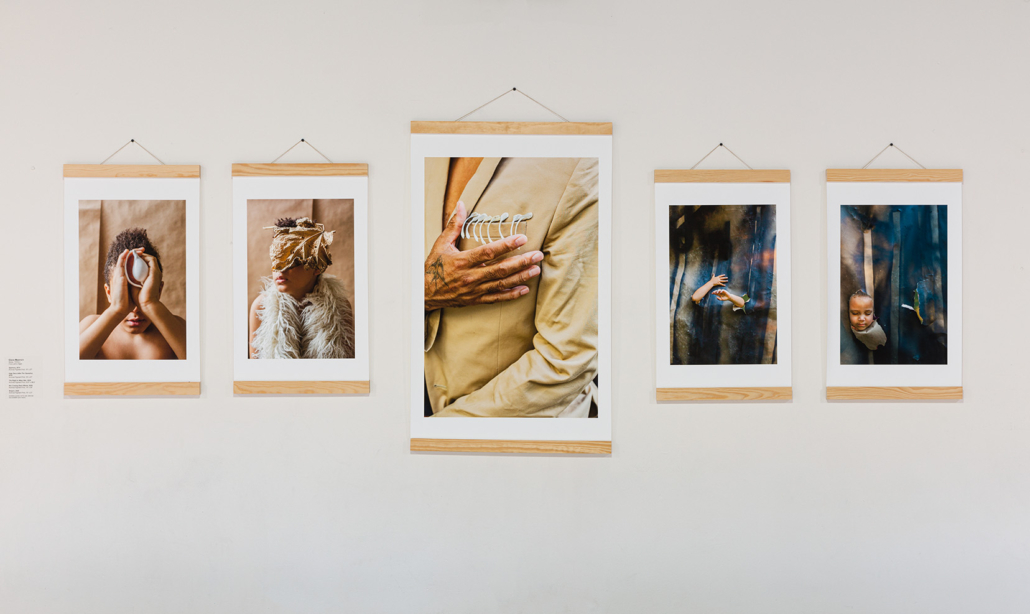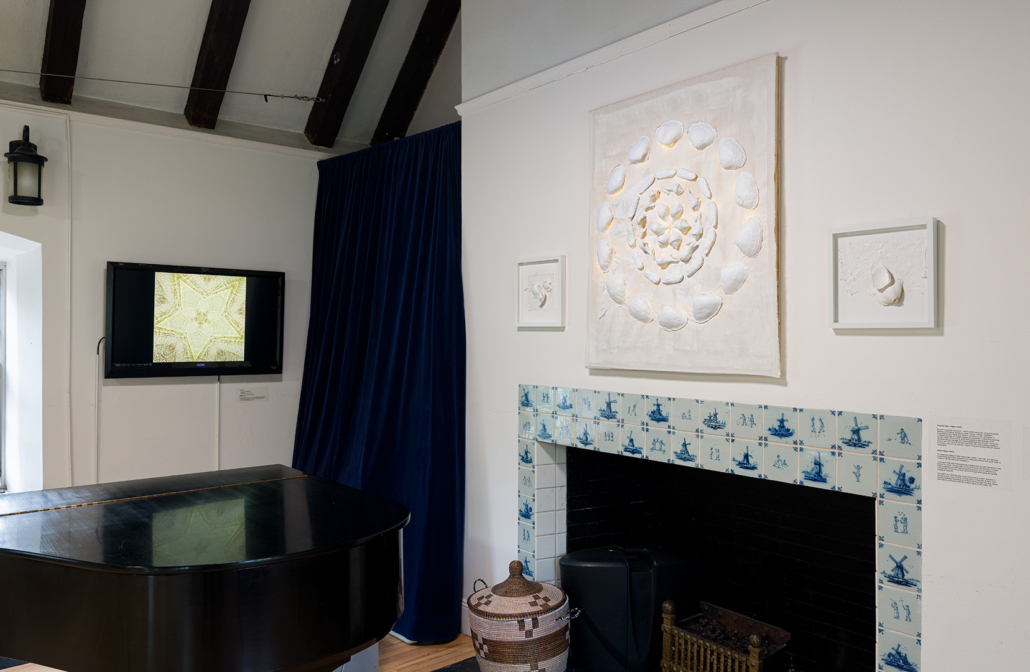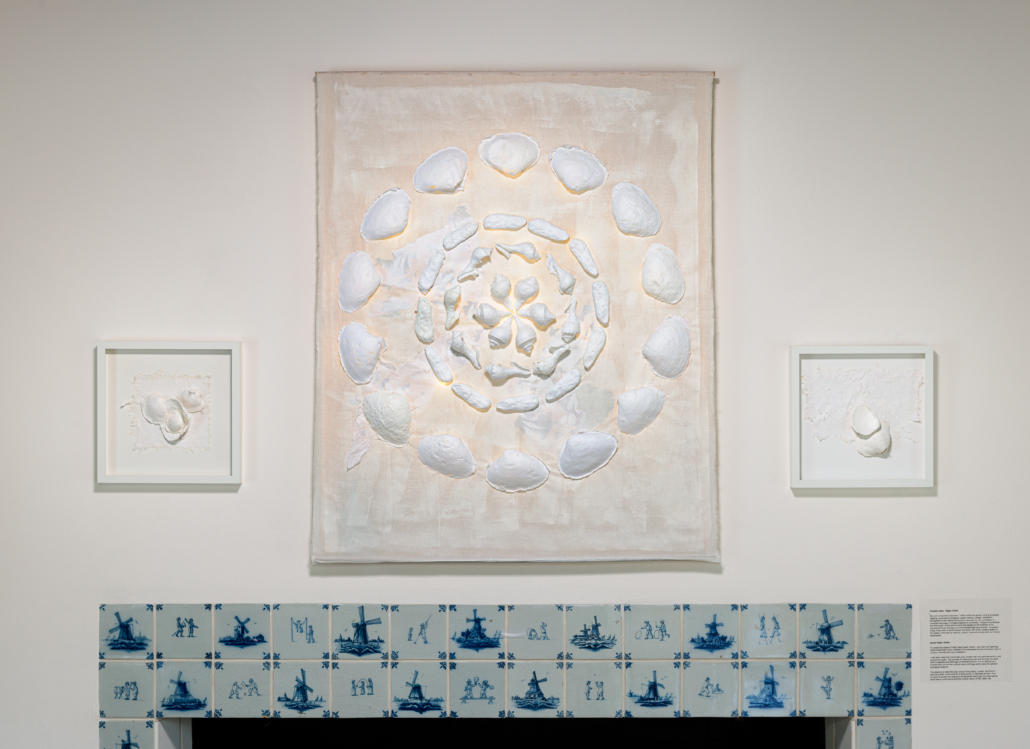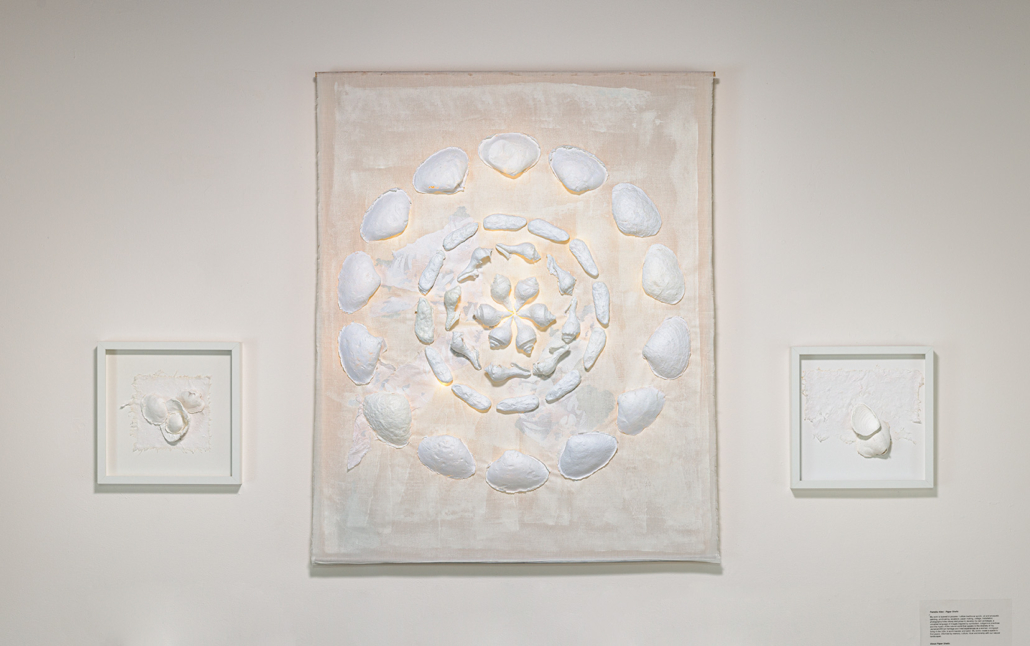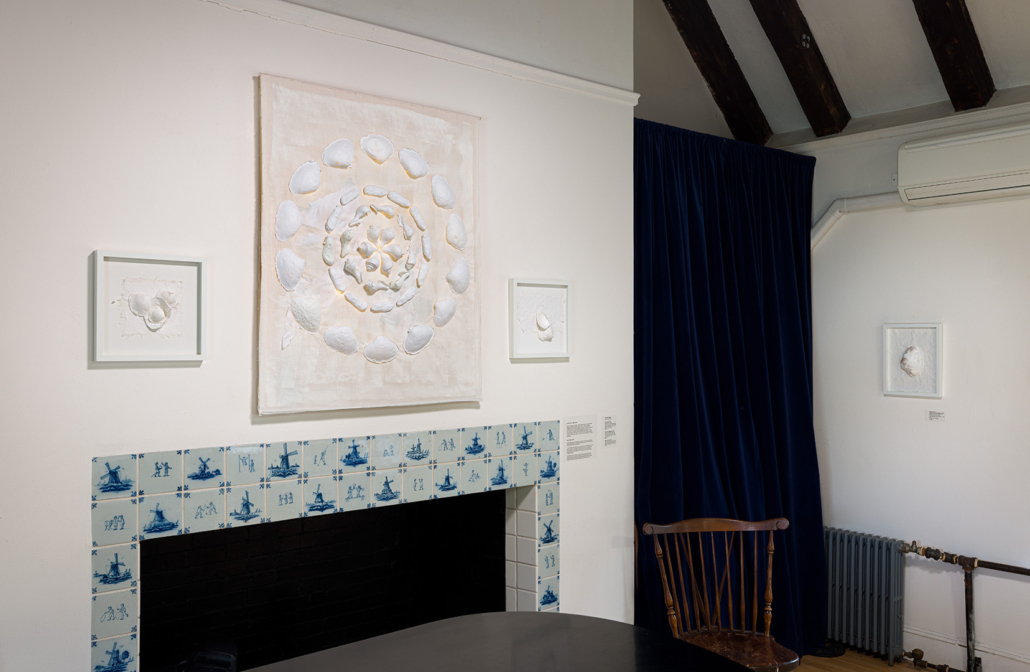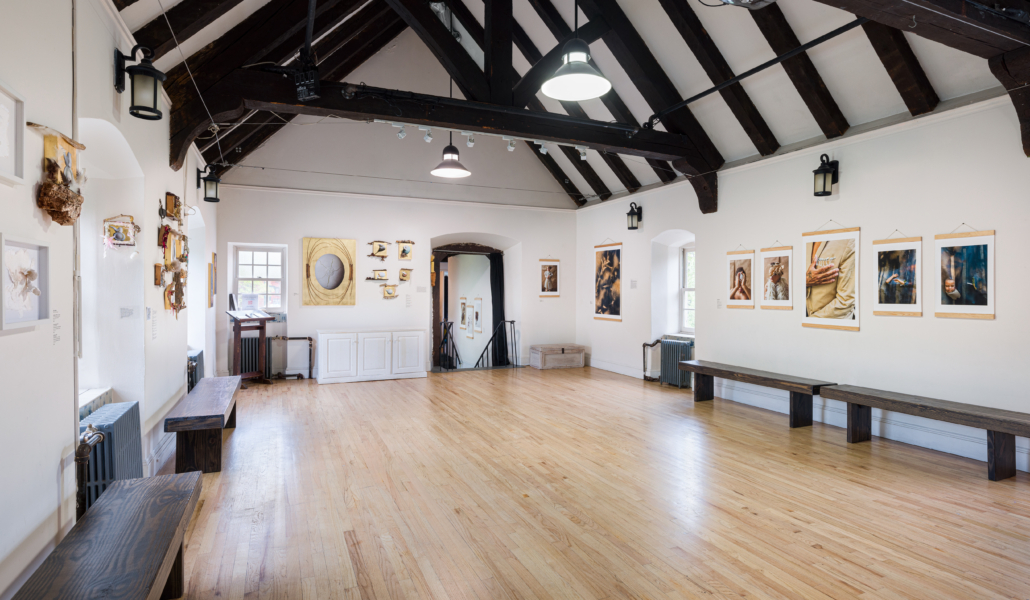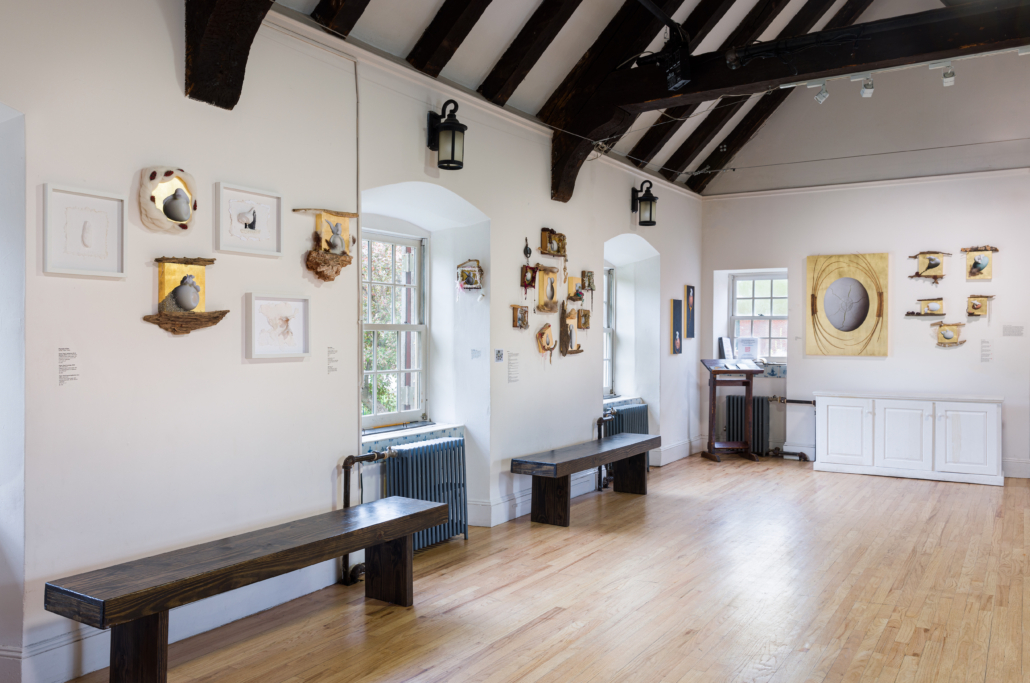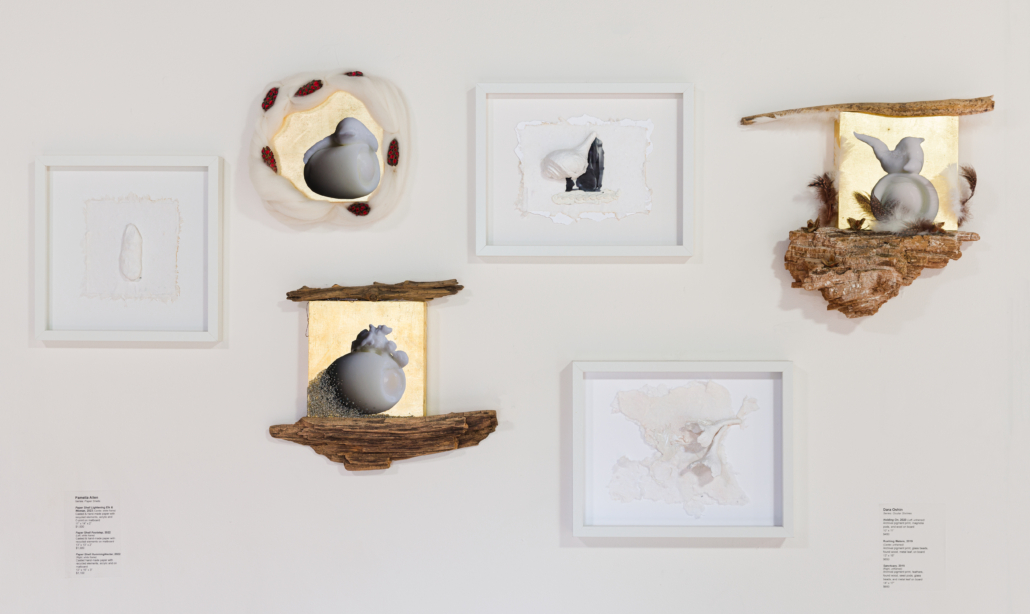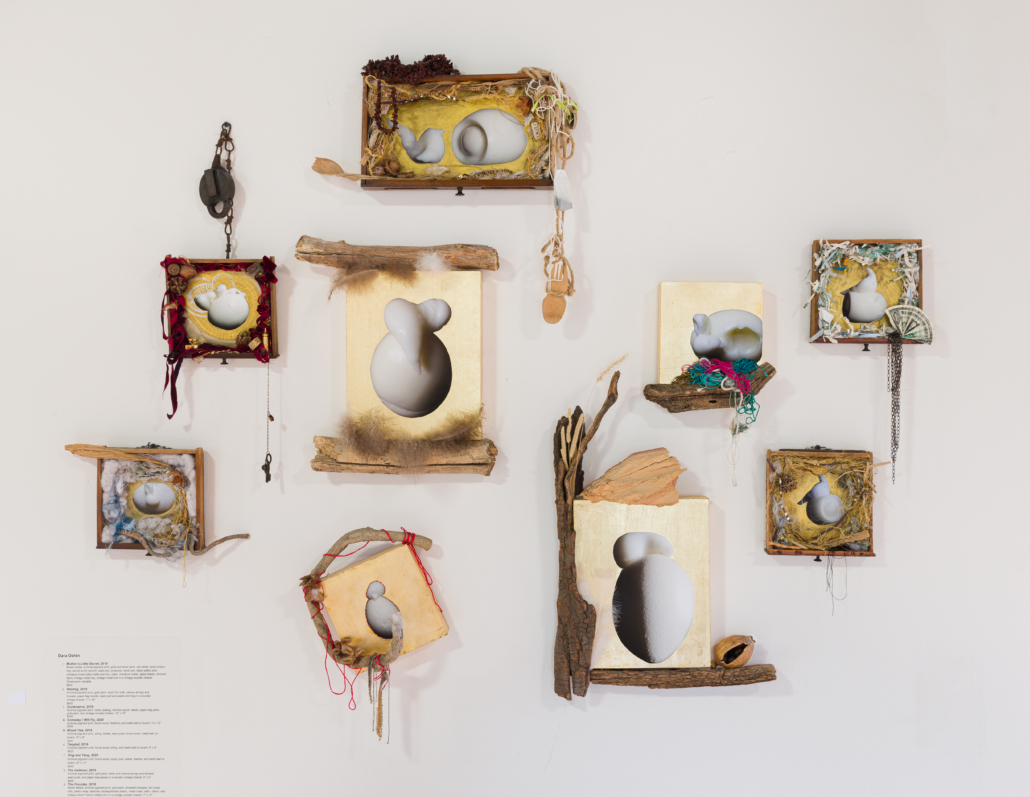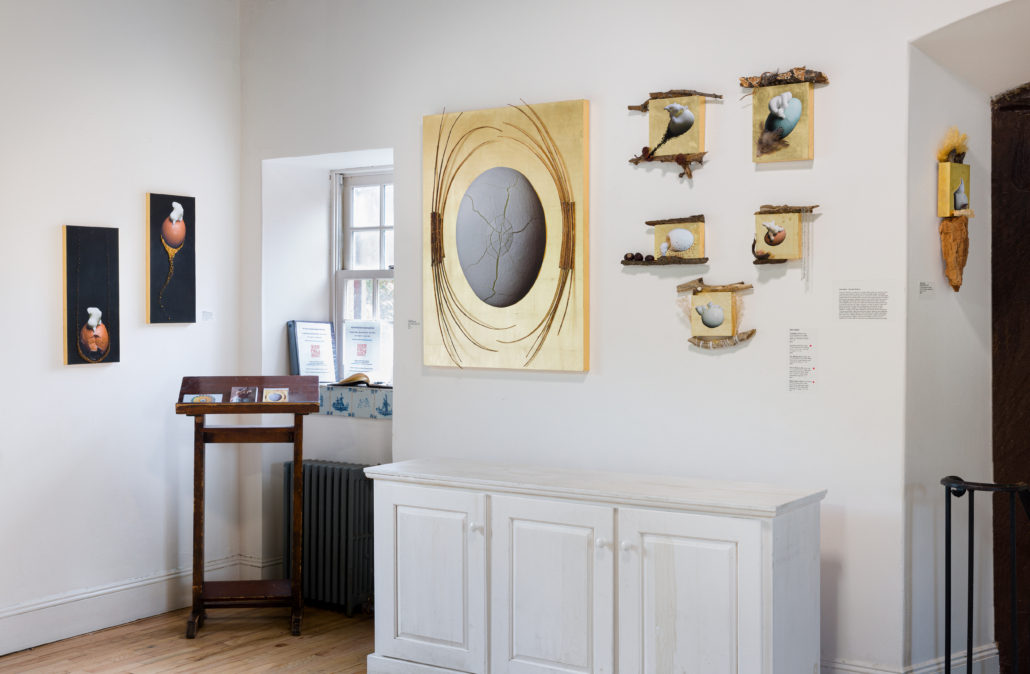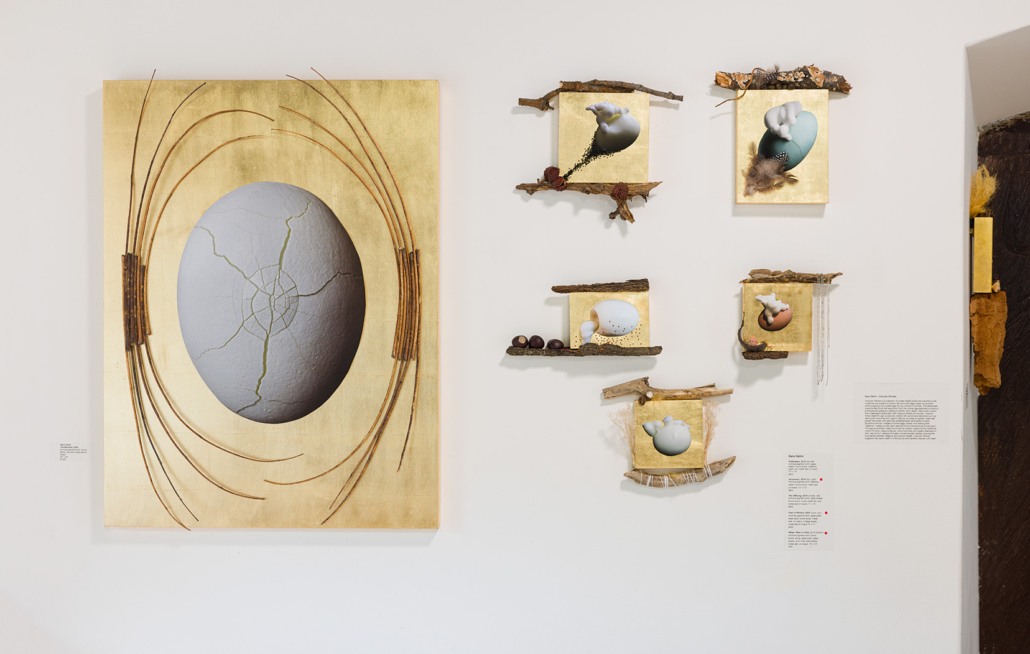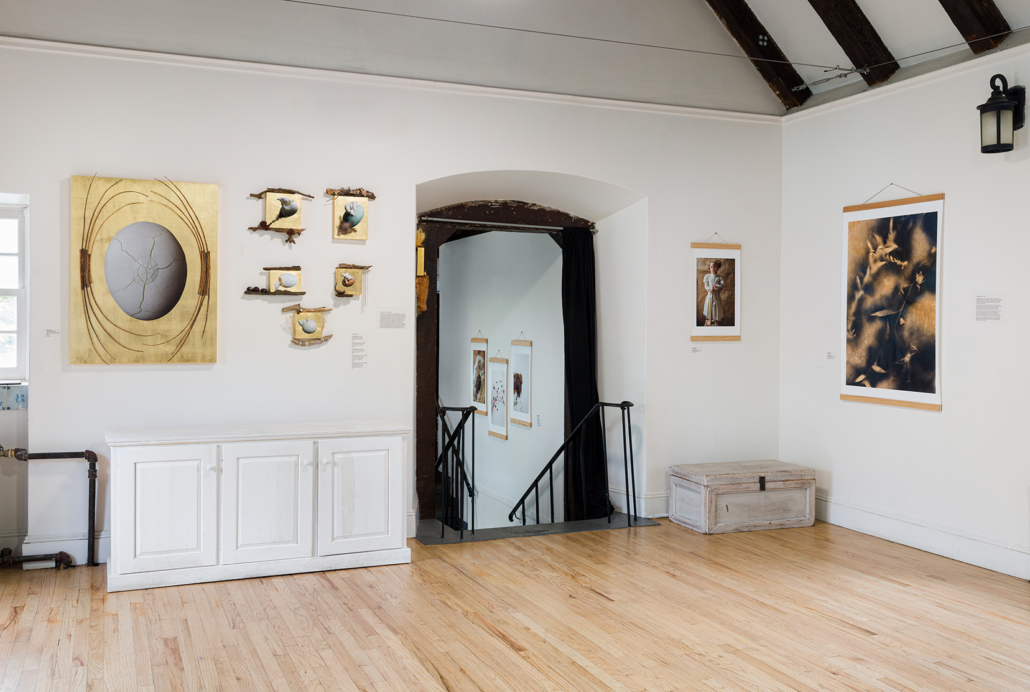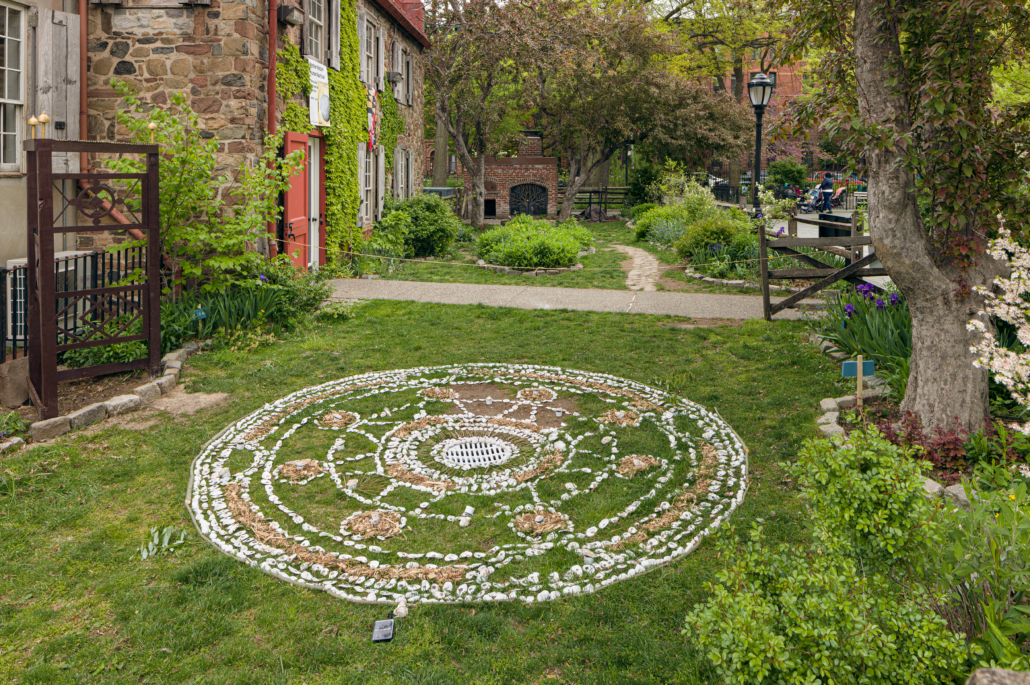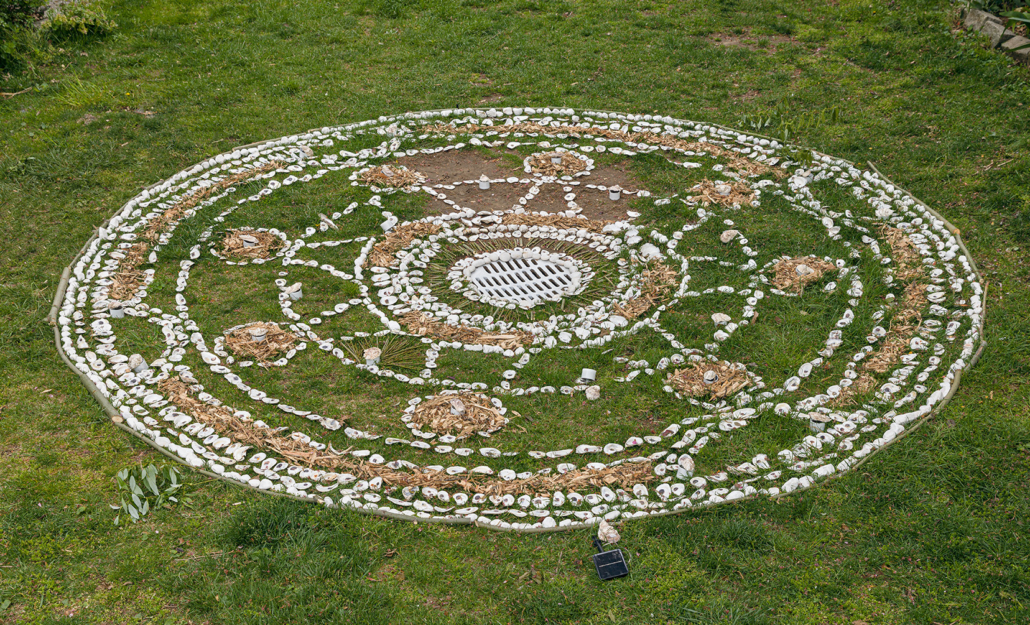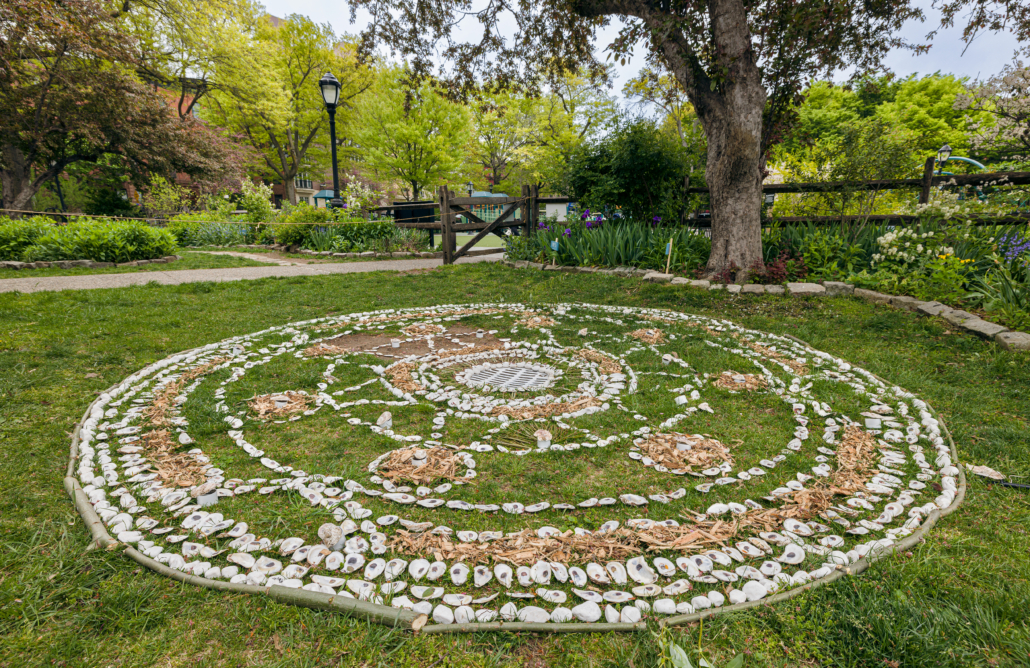This Exhibit is past. Visit our Exhibitions page for information on the current programming.
Mother Nature/Human Nurture
On View: April 27 – June 26, 2023 see our calendar for visit hours.
Opening Reception: April 27 from 6 – 8 pm.
Public Program: FINDING CENTER – Nature Speaks History on May 13 at 11 am with artist Pamella Allen, click here for more information.
Artworks for sale can be purchased here from Why Not Art.
Artists: Dara Oshin, Qiana Mestrich, & Pamella Allen
Enjoy this virtual tour slide show of the exhibition, photographed by Etienne Frossard.
Overview:
Healing, breaking, regrowth, fertility, spirituality – works in this exhibition explore the complex interconnections among nature, nurture, sustenance, renewal and the cycles of life. Mother Nature/Human Nurture presents works by artists Pamella Allen, Qiana Mestrich, and Dara Oshin in a range of media, including natural materials and human-made representations of the same. They investigate nature as a life source that is universal and spiritually grounding among a diverse set of cultural perspectives. Inspired by their own experiences as caregivers, all three artists eschew traditional figurative representation of motherhood and care in favor of symbolic natural elements that also have strong local and cultural associations: eggs/birds, leaves/branches, bones, seashells, mandalas.
By connecting the repetitive yet regenerative activities of caregiving with natural and spiritual phenomena, the work in this exhibition serves to elevate the role of both the “human nurturer” and the natural environment and suggest their interdependence during a time when our ability to care for both our environment and each other is under threat. Some of the work was made in collaboration with or in reference to specific children, relatives or community members.
Dara Oshin’s Oracular Shrines is a collection of mixed media sculptures inspired by the mysteries and powers of nature. Oshin’s work with eggs began by accident while preparing hard boiled eggs for her children’s lunches. The abstracted creature-like forms that were born from the mother egg sparked a myriad of philosophical questions relating to fertility, birth, death, nature and nurture that challenged traditionally held religious beliefs and stories. Oshin explores these ideas through sculptures created with ephemeral elements such as seed pods, branches and organic detritus mounted on golden metal leaf panels decorated with gem-like embellishment reminiscent of early Byzantine shrines. Images of boiled eggs, broken and leaking their “essence,” create surreal, semi-abstract forms that serve as a focal point. The egg as animistic object becomes the subject, replacing the traditional Judeo-Christian religious figures, while branches and organic elements in their natural form replace intricately carved wooden objects, blurring the boundaries between religious and secular beliefs. Says Oshin, “Oracular Shrines suggests that nature itself is a life source and therefore sacred unto itself.”
Qiana Mestrich’s THRALL (2017-2020) “endorses the Black Mother’s role as Creator, Author and Photographer. She is no longer hidden as a prop or depicted as forced labor. She is superhuman and in control of the image, utilizing the home and the ‘open air’ as her studio.” Borrowing from traditions of outdoor studio, staged portraiture, still life and family photography, the work makes connections between an African diasporic past and present through the use of ritual yet personal objects like a cowrie shell, coral, and wishbones. Some images seamlessly juxtapose human, animal and plant elements. In others, brown craft paper backdrops reference “the absurdity of historic racial tests and skin-color bias in photography.” Many of the images in THRALL were made during the pandemic, when the artist’s family moved from Brooklyn to upstate NY, their first experience as landowners. This gave them the opportunity to “(re)discover an unenclosed, Black relationship to the outdoors.” Says Mestrich, “collaborating with my children, I allow them to dance, be unruly, wondrous and curious in Nature, moving towards an understanding and acceptance of all things natural.”
Pamella Allen’s mixed media works evoke a universal idea of care. They aim to “create a space to find peace, informed by memory, culture, ritual and kinship with our natural landscapes.” Her unique visual language is inspired by indigenous practices and symbolism that speak to her Jamaican/African heritage and lived experiences as a woman, immigrant, world traveler and sailor as well as a teaching artist in diverse educational and healing settings. Allen’s paper shell assemblages are crafted with handmade recycled paper, conveying the artist’s commitment to sustainability. Her mandalas of repetitive earth elements, text and photographic images allude to the therapeutic, ritual and storytelling use of the mandala by various cultural groups. Her new video painting series creates more immersive mandala-like experiences. The mandala spiral is also prominent in Allen’s collaborative earthworks, which incorporate elements from their local landscapes to “ honor the natural world and provide a self portrait of the landscape–a visual history told with the bones and discarded homes of sentient beings.”
About The Artists:
Pamella Allen (she/her) is a Jamaican born, Brooklyn based visual artist in practice for over 30 years whose works have been exhibited in traditional gallery and non-traditional settings, in site specific public art corporate commissions for healing spaces such as Bellevue Hospital for the HHC Art-In-Medicine program, community centers and private collections across the globe. Following “a calling to make art with the youth” while living in Africa and then while in residency in India; in addition to her continued studio practice, for the past 12 years Pamella has been in practice as a teaching artist sharing her creative process with community in school settings, senior centers, museums, and healing spaces throughout New York with organizations creating site specific public arts mural, mixed media installations, and anthologies for publication.
Qiana Mestrich (she/her) is a photography-focused, interdisciplinary artist based in New York. She has been exhibited worldwide including the international Triennial RAY Fotografieprojekte Frankfurt/RheinMain, the BRIC Biennial: Volume III and London Art Fair’s Photo50. Mestrich’s work is held in the Peggy Cooper Cafritz collection of contemporary art and other private collections in the United States. In 2022, she was a recipient of the Magnum Foundation’s Counter Histories grant for her project on the history of women of color in the corporate workplace. Knowledge sharing and community building is a vital part of Mestrich’s practice. In 2007 she founded Dodge & Burn: Decolonizing Photography History, an arts initiative that aims to diversify the medium’s history by advocating for photographers of color. Dodge & Burn began as a blog and from 2014-2022 functioned as a monthly critique group meeting in-person and virtually. Her forthcoming book based on the blog’s past interviews will be published by Routledge/Taylor & Francis. Mestrich has written essays on photography for exhibition catalogs and published critical writing in art journals such as Light Work’s Contact Sheet and En Foco’s Nueva Luz. She was also co-editor of the book How We Do Both: Art and Motherhood (Secretary Press), a diverse collection of honest responses from contemporary artists who dare to engage in the creative endeavors of motherhood and making art.
Dara Oshin (she/her) is a visual artist working in a variety of media including painting, drawing, assemblage, photography and sculpture. She grew up in New Jersey on the edge of the woods and next to a farm where she spent her days immersed in nature. This early exposure to flora and fauna continues to inform much of her work today. After earning her BA with a major in English and a minor in Studio Art, she traveled and lived abroad for a decade. During that time she studied painting, drawing and pottery at a variety of schools and private ateliers. Dara’s work has been shown in solo and group exhibitions locally and abroad. In 2015, she Illustrated a children’s book which won a Bronze Moonbeam Award. Dara currently lives in Brooklyn, NY with her family and her very fuzzy dog.
About The Curators:
Grace R. Freedman, PhD (she/her) is a founder of Why Not Art which celebrates the vitality of the Brooklyn arts community by presenting interdisciplinary art shows in alternative spaces to reach expanded and diverse audiences. Why Not Art has produced 10 community art exhibits in Brooklyn in the last 18 months, including acting as guest curator for BELONGING: A Textile Arts Exhibit at the Old Stone House. Contact: grace@whynotart.com; 718-858-4847, IG @whynotartnyc
Katherine Gressel (she/her), contemporary curator, Old Stone House & Washington Park, earned her BA in art from Yale and MA in arts administration from Columbia. In addition to organizing over a dozen major exhibitions to date at OSH, Katherine has curated and produced artist projects for Brooklyn Botanic Garden, Smack Mellon, FIGMENT, No Longer Empty, St. Francis College, and Brooklyn Historical Society, and was the 2016 NARS Foundation emerging curator. Katherine has written and presented on art and social impact for Americans for the Arts and Public Art Dialogue, among others. Katherine also served as Programs Manager at Smack Mellon Gallery from 2010-2014, and has worked and consulted for diverse nonprofits. Contact: katherinegressel@gmail.com; 917-684-2109
Featured image by Dara Oshin.
This exhibition is made possible, in part, by the New York City Department of Cultural Affairs and the New York State Council on the Arts with the support of the Office of the Governor and the New York State Legislature.



